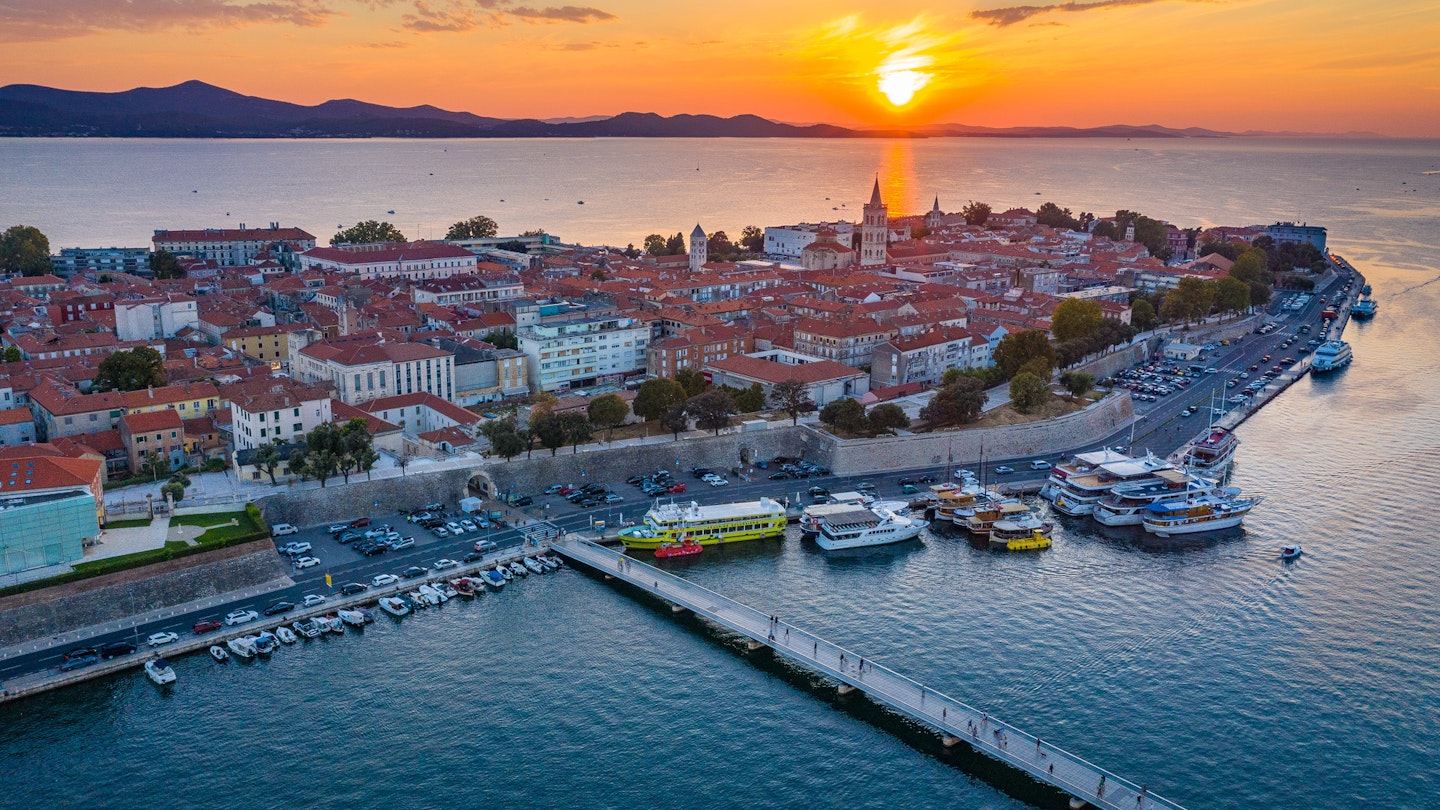Discovering Zadar: A Historic Croatian Gem
Zadar has always been a crossroads for various peoples and civilizations, all of whom have left their mark on this enchanting city. Roman ruins, Venetian fortifications, Romanesque cathedrals, and Byzantine churches are just some relics of its vibrant cultural past.
Today, this historic city on Croatia’s Dalmatian coast attracts art and history enthusiasts, sea and sun seekers, and even digital nomads who are drawn to the city’s fast 5G network. Visitors congregate in the old town’s lively squares, which are lined with cafés, as well as along the waterfront promenades where they can take in the sights or embark on day trips to nearby natural wonders.
Foša and the Land Gate
Most of Zadar’s attractions are located in its compact old town, which sits on a narrow peninsula jutting into the Adriatic Sea. The town is interlaced with a grid of cobblestone lanes laid by the Romans.
Begin your journey at Foša, a quaint marina flanked by the majestic Land Gate. This historic entrance, constructed by the Venetians in 1543, invites you to look up and spot the winged Lion of Saint Mark, a symbol of the Venetian Republic, peering down from the central arched gateway. Just below him is St. Chrysogonus, Zadar’s patron saint, seated on horseback.
Kalelarga
While exploring the old town, you might encounter contemporary structures alongside architectural relics from different eras. The modernist buildings, characterized by neat geometrical lines from the 50s and 60s, create an architectural contrast especially visible on Široka ulica, the old town’s main street affectionately known as Kalelarga. Here, box-like edifices rise on concrete pillars, providing a sheltered walkway for leisurely city strolls.
Zadar City Walls
In the 16th century, the Venetians fortified the city with defensive walls, built upon remnants left by the Romans. Known locally as Muraj, these walls were recognized by UNESCO in 2017 as part of the 16th and 17th-century Venetian Works of Defense. By 2020, the city walls underwent significant restoration, transforming into a beautiful tree-lined promenade complete with benches and stunning sea-facing viewpoints.
Roman Forum and St Donatus’ Church

Make your way to Zeleni Trg, home to the ancient Roman Forum, where the city’s oldest and most remarkable churches are located. Dominating this square filled with the stone remnants of ancient structures is St Donatus’ Church. Constructed in the 9th century, the church stands as a stunning example of Byzantine architecture in Dalmatia, boasting an imposing circular dome that stands 88 feet high. Today, it serves as an exceptional venue for concerts, thanks to its unique acoustics.
St Anastasia’s Cathedral and Bell Tower
The adjoining St Anastasia’s Cathedral was first established by the Byzantines in the 9th century but underwent a Romanesque reconstruction between the 12th and 13th centuries. It underwent further repairs following significant damage during World War II. Ascend the bell tower for breathtaking views over Zadar’s terracotta rooftops and the Adriatic Sea.
St Mary’s Church and Museum of Religious Art
Completing the Forum’s triptych of places of worship is the 1st century St Mary’s Church, featuring a Renaissance façade and a Romanesque bell tower. The adjacent Benedictine monastery now houses the Museum of Religious Art, showcasing 200 artifacts, some dating back to the 8th century.
Sea Organ and Sun Salutation

According to Alfred Hitchcock, “Zadar has the most beautiful sunset in the world, even more beautiful than that of Key West, Florida, which is applauded every evening.” To experience this breathtaking phenomenon as day transitions to night, head to the northwest corner of the old town where the sea meets the sky.
Expect an awe-inspiring view of the sun’s theatrical descent into the Adriatic Sea, accompanied by the haunting symphony of sounds produced by the Sea Organ, featuring 35 pipes hidden beneath the wide stone steps leading to the water.
Just a stone’s throw away, the Sun Salutation, a remarkable installation by local architect Nikola Bašić, awaits your visit. This visually striking creation, measuring 72 feet across and composed of 300 multilayered glass plates, absorbs sunlight during the day and produces dazzling light patterns at night.
Kolovare and Borik Beaches
If you seek relaxation by the sea, stroll south from the old town along the seaside promenade, where beach bars beckon, to reach the beautiful pebble beach adjacent to the prominent Hotel Kolovare. Alternatively, for those who prefer sandy shores, head north, passing the yachts docked at Borik Marina, to discover Borik Beach.
Nearby Islands of Ugljan and Silba

Zadar serves as a gateway to the nearby archipelago of islands. Regular ferries connect Zadar with Ugljan, an island known for its olive groves and charming holiday homes, as well as the adjacent Pašman Island, which is a local favorite for weekend getaways. The tiny island of Silba, spanning only six square miles, is entirely car-free. Its laid-back, bohemian atmosphere becomes notably energetic in summer months, where so many visitors come that bicycles are prohibited.
Zadar’s Parks

For adventure seekers, several parks in the Zadar region offer opportunities for outdoor activities. Paklenica National Park, in particular, is ideal for those looking to engage in an active pursuit. Known for its impressive canyons and mountainous landscapes, it stands as Croatia’s premier climbing destination. The park is best explored via approximately 100 miles of trails that lead to breathtaking caves, streams, mountain summits, and lush forests. Additionally, if you catch the ferry from Zadar to the island of Dugi Otok, plan a visit to Telašćica Nature Park, which boasts dramatic cliffs concealing serene bays, inlets, and smaller islets. Enjoy the tranquil shade provided by the pine, olive, and fig trees along Telašćica Bay’s southwestern shore, and marvel at the views of the picturesque Lake Mir as you explore the park.





